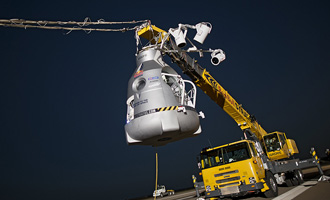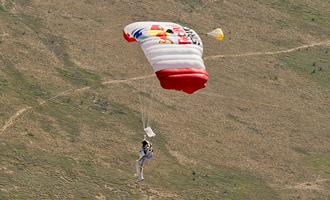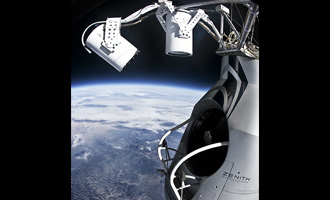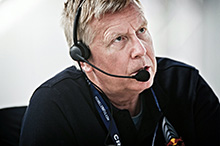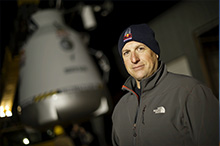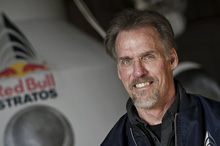
First Time in Human History!
A Supersonic Dive from the Stratosphere
October 14, 2012 – a man donning a spacesuit leaped towards the earth from a height of 39,000 meters. That man's name is Felix Baumgartner. His “Red Bull Stratos” challenge earned him the Faust of the Year 2012 Award. At Faust, we kept an eye on Baumgartner and gave him our enthusiastic support since before this project was announced, for being a B.A.S.E. jumper that continues to take on extreme challenges, exemplifying Faust. On this day, Felix was successful in the world's highest and fastest freefall (freefall without the use of any aerial vehicle). Not only did he achieve the first such record of mankind, but he also contributed to the development of human space science. This article will chronicle his achievements.
Project
The challenge that opened a new chapter in mankind's space development
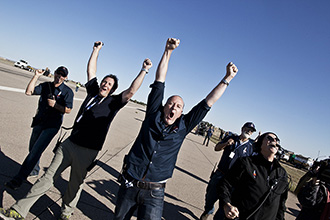
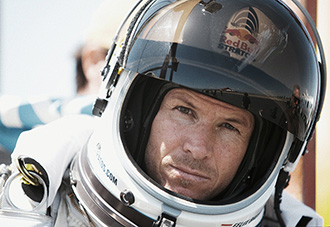 Felix Baumgartner
Felix Baumgartner
Born in 1969, in Salzburg, Austria, developed his parachute jumping expertise in the Austrian military. He won the world B.A.S.E jumping title in 1997, in West Virginia, USA. In 1999, he established the world B.A.S.E jump record at the Petronas Twin Tower in Malaysia and the world's shortest freefall at the Christ statue in Corcovado. In 2003, he wore a carbon fiber wing to be the first to cross the English Channel by skydiving. “Being second (to accomplish something) means nothing. Being the first to conquer world's number one means something” is his creed.
Roswell, New Mexico, is located in the American southwest. As the sun rose from the horizon at dawn, Felix realized that today's weather was cloudless, with the sky drawing a beautiful gradation of colors. There is no doubt that the shining morning sun and gentle breeze brought anticipation and excitement to all team members assembled at the desert. As broad daylight was arriving, the high altitude balloon filled with helium gas swelled up like a teardrop and began its climb. Before long, as the capsule carrying Baumgartner began to float, screams of joy emanated from the staff on-site and in the control room. It was a long road. It took seven years to get to this day, and at one point, there was even fear of cancellation. In the end, however, this massive project reached this day.
A man named Felix
In 2005, Felix and Red Bull began work on this stratosphere freefall project to test man’s limitations during flight (without the use of aerial vehicles). In this project called “Red Bull Stratos”, a man boards a balloon to climb 39,000 meters and leaps towards the earth. The project’s name signified a dive at heights and speeds that man had yet to experience.
Felix is a world renowned B.A.S.E. jumper. “B.A.S.E” is the acronym for “building”, “antenna”, “spans (bridges)”, and “earth”. It is an extreme sport filled with infinite danger where one dives using a parachute from places such as buildings and cliffs rather than from an airplane. Up to now, he established B.A.S.E. jumping records by diving from various places including the 101 Tower (509 meters high, located in Taipei) and the cave at Velebit National Park (190 meters deep, located in Croatia). He also achieved the record for the world's shortest descent, from the Christ statue on Corcovado mountain (overall length 36.9m, located in Brazil). At the Strait of Dover, he also achieved the world's first undertaking in history, skydiving from a height of 10,000 meters and crossing the strait with just a carbon fiber wing on his back.
Red Bull Stratos challenges the following four records: the highest manned balloon flight, the highest freefall (skydiving), first man to break the speed of sound in a freefall, and the longest free fall. There is also a noble cause behind these challenges. It is to utilize the various data he brings back from the unknown in a significant way towards future aeronautic and space development. During the 2010 press conference to announce the project, Felix stated, “As space development advances, the challenge will be to establish ways for astronauts to avoid emergencies that occur at high altitudes. I want to find out the changes that the human body undergoes in supersonic speed.” What happens to a person that descends at supersonic speeds? Can spacesuits protect humans? Will GPS equipment function? Can the parachute stabilize the descent? Felix will use his own body to answer these questions.
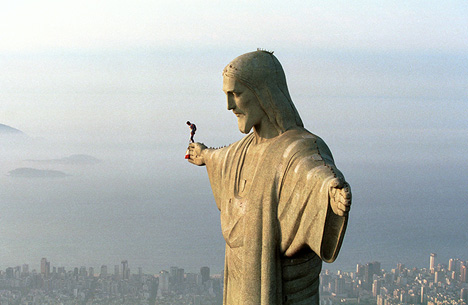
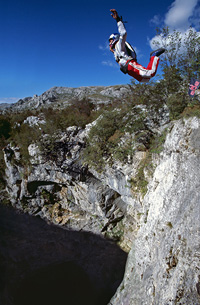 Left photo: Felix as he attempts to dive from the Christ statue in Corcovado. Right photo: October 2004, challenging the dive into the Mamet hole at Velebit National Park.
Left photo: Felix as he attempts to dive from the Christ statue in Corcovado. Right photo: October 2004, challenging the dive into the Mamet hole at Velebit National Park. From Faust A.G. Channel
Intro Footage of Felix
Technology
Scientific technology that enables surpassing the limits of the human body
Roswell, a town in eastern New Mexico, was chosen as the location for carrying out this mission. With its warm weather in addition to wide-spreading grasslands and desert, it was the ideal place for launching the balloon and was expected to stand a good chance of meeting the stringent requirements of the Red Bull Stratos challenge that include a cloud cover of 50% or less, visibility of 18,288 meters or more, and wind speeds of 6.44 kilometers per hour or less. The high-altitude helium balloon used is made from polyethylene film and is surprisingly thin at 0.02 mm. At the start of the flight, it stretches 168 meters (550 feet) forming a reverse teardrop shape, however, it expands to a diameter of 130 meters (424.37 feet) in the stratosphere, taking the capsule carrying Felix to the destination. Then, once the balloon reaches an altitude of approximately 39,000 meters, the balloon will mostly be under vacuum. Normally, commercial airplanes fly at an altitude of approximately 12,000 meters (the beginning of the stratosphere from the earth). However, at three times this height, the earth looks blue, just like in outer space. Being in these altitudes without body protection, the blood will boil. To combat this, Felix will wear a pressure suit and helmet designed for astronauts. This suit was specially developed over a course of 36 months to withstand supersonic speeds and temperatures expected to drop below minus 72 degrees. In addition to the pressure suit, many of the latest technologies, such as a backup safety system to prepare for emergencies, were sunk in to the Red Bull Stratos project.
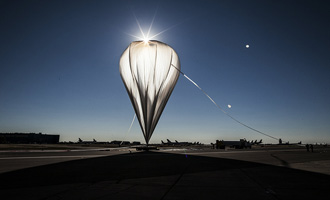 Balloon
BalloonThe high altitude helium balloon has the power to climb while withstanding a load of 3600 kilograms. In the approximately two hours it takes to reach the target altitude, the helium inside the balloon continues to expand. The thickness of only 0.02 millimeters is about 1/10 that of a “zip-lock” bag and can only be inflated twice.
 Pressure suit
Pressure suit
The pressure suit and helmet protects Felix from the extreme cold of minus 72 degrees and heat from friction. It was designed with aerodynamic stability during free falls in mind. It is equipped with a parachute, oxygen cylinder, and GPS system.
People
An amazing team that includes a hero from half a century ago
Incidentally, the current world skydiving records are 31,332 meters for height, 4 minutes 36 seconds for the longest fall, and 988 kilometers per hour for the fastest fall. Surprisingly, all of these records were established by one man in 1960, and they were achieved during a project conducted by the US air force. The man that proved over 50 years ago that humans can survive a dive from super high altitudes in the sky is former US Air Force colonel Joe Kittinger.
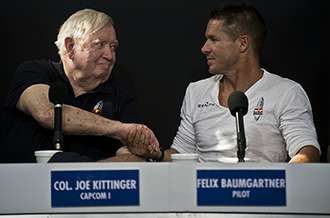 Joe Kittinger (left) and Felix Baumgartner, as they fielded questions during a press conference on the day of the mission. On August 16, 1960, Kittenger fell from a height of 31,332 meters. He experienced a freefall of 4 minutes 36 seconds until the parachute was to open at approximately 5500 meters.
Joe Kittinger (left) and Felix Baumgartner, as they fielded questions during a press conference on the day of the mission. On August 16, 1960, Kittenger fell from a height of 31,332 meters. He experienced a freefall of 4 minutes 36 seconds until the parachute was to open at approximately 5500 meters.
“Up to now, countless people lost their lives challenging my record. But I believe that this project will definitely succeed because of Felix's renowned expertise, Red Bull's dedicated support, and the excellent team that has been assembled,” stated Kittinger. Kittinger, who spoke bearing gray hair, joined the Red Bull Stratos team in 2008.
Danger of project cancellation
Blessed with a great team, the project seemed to be progressing smoothly. In reality, however, the project faced danger of cancellation in October 2010. Someone planning a stratosphere dive to break Kittinger's record filed a lawsuit. For the one year and four months until this lawsuit could be resolved, the Red Bull Stratos project was placed on hold. Before long, in the spring of 2012, team members reassembled. Many professionals came together and preparation to send Felix off into the stratosphere recommenced. These professionals included retired Navy commander Doctor Merle Hewett, who does consulting for the aerospace industry; Andy Walsh, a doctor in biomechanics who has guided many athletes to victory; and Doctor Jonathan Clark, an authority on space medicine and neurology. And finally, they reached the point where they could be rewarded for the time spent on the project.
Success
The world of supersonic speeds experienced by the human body
October 14, 2012 – two hours after the balloon lifted off the ground, Felix found himself approximately 39,000 meters high in the atmosphere. “Everything will be fine”. The test dive conducted in July from a height of approximately 29,500 meters was a success. Even at 10,000 meters higher, success was expected as long as it was executed according to the repeated training. Back on earth, friends and family kept watch. After going through all 39 items in the checklist, Felix depressurized the capsule and opened the door. The blue earth was shining softly in dark space. Cameras outside of the capsule captured Felix as he stepped out on to the platform. Shortly thereafter, Felix flung himself as if he was being swept in towards the earth. The descending speed exceeded expectations. The sound barrier was broken 50 seconds after the dive began and the maximum speed reached 1342 kilometers per hour (Mach 1.2)! Normal attitude control was futile in high altitudes without air. It was expected from this that one would faint if rotations continued for a long period. Video of the control room showed his family and girlfriend glued to the monitor. As Kittinger desperately called out to Felix, Felix somehow controlled the rotations, stabilizing his position - truly an escape from the brink of death. Shouts of joy emanated from the control room! Felix continued to descend while responding to communication with Kittinger and opened his parachute at an altitude somewhere between 2000 and 3000 meters. The freefall lasted 4 minutes and 19 seconds. “Whoo!” Everyone in the control room celebrated with an ovation after seeing him land in the desert. Felix's sound footing made it seem as though this feat was achieved easily, but he said as follows after the jump, “When my body started spinning, I thought I would spin two to three times, but the rotation speed began to accelerate and I thought for a moment there that I would lose consciousness. It was a tough project.”
 An overjoyed Felix after returning to earth.
An overjoyed Felix after returning to earth.
Felix and the team set their sights on four world records, but they could not surpass the longest freefall of 4 minutes and 33 seconds. However, a new record was added to the three records, establishing a total of four records. This moment was televised live throughout the world. People held their breath and watched as they shared a monumental dream come true, thanks to one daredevil of a man and the corporations that fully supported him. His challenge also brings a host of data to be shared towards future development of safety in outer space. In this way, the Red Bull Stratos, a project that took seven years, came to be a historic project that opened a new chapter for mankind.
World records broken
・ Man's first freefall breaking the sound barrier/1342.8 kilometers per hour (Mach 1.2)
・ Man's highest freefall/height of 39,045 meters (128,100 feet)
・ Longest vertical freefall distance/ height of 36,529 meters (119,846 feet)
Note: The actual numbers are tentative until certified.
Future Collaboration by Red Bull Stratos
・ Development of next-generation space suits including their improved mobility and visibility, as well as support for the development of new systems to allow passengers and crew to escape safely in outer space.
・ Aiding in creating manuals to handle high altitudes, as well as high speeds and accelerations.
・ Aiding in the study of the effects of acceleration and deceleration on the body at supersonic speeds (includes development of the latest parachute system).
From Faust A.G. Channel on [YouTube]
A video message from Felix shown at the 2012 Faust A.G. Awards. You can see the freefall footage along with Felix’s own explanations (from around 2:55).
★This video can also be found on Faust A. G.’s YouTube channel. (Recommended for smartphone users.)
Translation: Paul Tokunaga
Text:Chie Odashima
Photos:Redbull Stratos
ENG version: 2013/01/31
Original JPN version: 2012/12/27
SOUL
-

Internet Donations Alleviate Poverty and Create New Markets
2013/2/14 -

First Time in Human History!
A Supersonic Dive from the Stratosphere
2013/1/31 -

Youngest person ever to circumnavigate the world solo, on a yacht!
16 y.o. attains her goal: "This is my way of life."
2012/7/05 -

Finally Relaunched!
- The Red Bull Stratos World's Highest Altitude
Stratosphere Dive Project
2012/6/07

